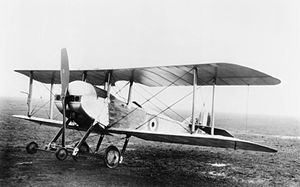Martinsyde S.1
| S.1 | |
|---|---|

| |
| Role | Single-seat scout |
| Manufacturer | Martin-Handasyde |
| Introduction | 1914 |
| Primary user | Royal Flying Corps |
| Number built | 60 |
The Martin-Handasyde Scout 1 was a British biplane aircraft of the early part of the First World War built by Martin-Handasyde Limited.
Design and development[]
It was a single-seat biplane with a Gnome engine in tractor configuration.
Operational service[]
This section focuses too much on specific examples without explaining their importance to its main subject. (January 2017) |
Sixty of the S.1 were built and these were used for about 6 months on the Western Front by the Royal Flying Corps before it was relegated to training. Although initially intended for use in Home Defence operating from the UK, it was found to be inadequate for that too. It was reported to be unstable, and it was the aircraft Captain Louis Strange was flying in a combat with a German two-seater, when one of the oddest incidents of WW1 took place. He was changing a drum on his overhead Lewis gun, when the aircraft turned over - and he fell out. However, he held on with one hand to the spade grip of the gun, and somehow managed to hook one leg into the cockpit, then the other. The plane righted itself, and he fell back in, breaking the seat. The German crew, convinced they saw their opponent fall out, claimed a kill, and were (so it was said by the ace, Bruno Loerzer, who was based in the area), ribbed afterwards, when no wreckage was found. ('The Friendless Sky' - A McKee)
Operators[]
- Royal Flying Corps
- No. 1 Squadron RFC
- No. 2 Squadron RFC
- No. 4 Squadron RFC
- No. 5 Squadron RFC
- No. 6 Squadron RFC
- No. 9 Squadron RFC
- No. 10 Squadron RFC
- No. 12 Squadron RFC
- No. 14 Squadron RFC
- No. 16 Squadron RFC
- No. 18 Squadron RFC
- No. 19 Squadron RFC
- No. 20 Squadron RFC
- No. 22 Squadron RFC
- No. 23 Squadron RFC
- No. 24 Squadron RFC
- No. 25 Squadron RFC
- No. 30 Squadron RFC
Specification[]
Data from War Planes of the First World War: Volume One Fighters. [1]
General characteristics
- Crew: One
- Length: 21 ft 0 in (6.4 m)
- Wingspan: 27 ft 8 in (8.43 m)
- Height: 27 ft 8 in (8.43 m) [2]
- Wing area: 280 sq ft (26.01 m2)
- Powerplant: 1 × Gnome rotary piston , 80 hp (60 kW)
Performance
- Maximum speed: 87 mph (140 km/h, 76 kn)
Armament
- Forward firing 0.303in (7.7mm) Lewis machine gun
See also[]
Related lists
References[]
- Notes
- Bibliography
- Angelucci, Enzo. The Rand McNally Encyclopedia of Military Aircraft, 1914–1980. San Diego, California: The Military Press, 1983. ISBN 0-517-41021-4.
- Bruce, J.M. War Planes of the First World War: Volume One Fighters. London: Macdonald, 1965.
- Bruce, J.M. The Aeroplanes of the Royal Flying Corps (Military Wing). London: Putnam, 1982. ISBN 0-370-30084-X
External links[]
| Wikimedia Commons has media related to Martinsyde S.1. |
- 1910s British fighter aircraft
- Martinsyde aircraft
- Aircraft first flown in 1914